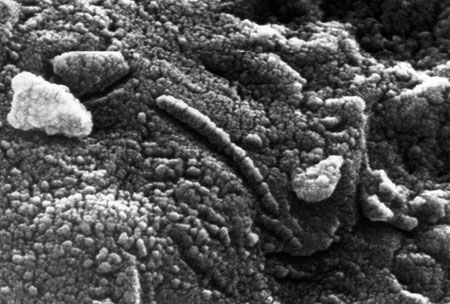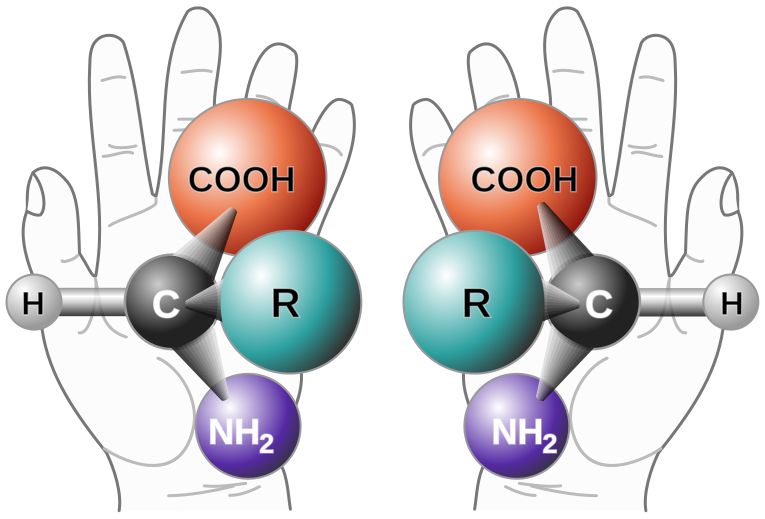Well, probably not like this.
But it does carry instrumentation designed to look for biosignatures, evidence that simple microbial life may have existed at some point in the Martian past, even if it no longer does so.
First, a few basic items of information:
• No one expects to find complex life on Mars or indeed anything beyond whatever the Martian analog to bacteria might be. Current Martian conditions are simply too harsh, and past more hospitable conditions too fleeting, for any such possibility.
• There are landforms all over Mars that show evidence of liquid flow—what look like dry river beds, ancient lakes and other surface features that mimic ones on Earth known to be the result of massive floods. A few examples below:



• Life as we know it—which is of course the only sort of life about which we can really say anything sensible –requires liquid water.
• Mars is currently too cold and its atmosphere is too thin for liquid water to exist on the surface. Any exposed water would quickly freeze and then sublime (turn directly into water vapor), except near the poles, where it is VERY cold. There are ice caps of both water ice and carbon dioxide (dry) ice at both poles.
• Mars does have significant amounts of subsurface ice, and it is quite close to the surface in the polar regions. There are Earth microbes which can live in ice (by creating “antifreeze” proteins that melt it), and perhaps there are similarly adaptable Martian organisms.
• There are clays on Mars whose Earthly analogs are almost always created by standing bodies of water that interact with rocks. Although recent reports propose an alternative means for the creation of these clays, they are seen as the strongest evidence that Mars was once warmer and wetter, perhaps long enough for life to have evolved.
• There have been three missions to Mars that specifically looked for biosignatures: the two Viking landers in the 1970s, and the Phoenix lander in 2008. While there were some interesting and possibly ambiguous results, no clear and convincing evidence of past or present life emerged.
So what are some biosignatures that might tell us there is or was life on Mars? Let’s arrange this in order from the least to the most ambiguous, from ones that would have everyone agreeing on the existence of (simple) Martians, to ones that would find proponents on both sides of the issue.
1. Accumulations of organic matter, similar to oil-rich shale deposits on Earth.
2. Fossilized bacteria. You may recall the excitement about twenty years ago over the claim that these had been found in a meteorite known to have come from Mars.

The emerging consensus is, however, that these structures are too small to represent fossilized cells.
3. Biogenic rock formations similar to limestone, which is formed from the shells of marine life on Earth.
4. Chirality. This is a word for the characteristic of certain molecules to come in either of two forms that we can designate left or right-handed. While your two hands are certainly similar, they are just as certainly not identical! Inorganic processes tend to produce these molecules in a 50-50 mix of the two forms, while organic processes—life—tend to produce one or the other form.

5. Isotope patterns. Carbon is taken up by all Earth organisms, and it has two chemically identical stable isotopes, 12C and 13C. Organisms preferentially take up the lighter 12C and are therefore depleted in 13C relative to inorganic material. If these organisms then fossilize, the depletion of 13C in the fossils is a telltale sign of past life.
6. Atmospheric gases. On Earth, the presence of oxygen in the atmosphere is a sure sign of life. Oxygen is a highly reactive gas! If all life were to disappear from Earth tomorrow, atmospheric oxygen would also disappear fairly quickly as it reacted with surface material. It is only because it is constantly replenished by life processes that is can maintain a level of 21% of our atmosphere.
The Martian atmosphere is almost all carbon dioxide, a very chemically stable gas that can persist in an atmosphere for eons. But there are also traces of methane, and that’s a different story. Methane does not react with rocks in the way that oxygen does, but it is decomposed by solar radiation quite rapidly. Methane is both produced and destroyed in the Martian atmosphere more rapidly than can easily be explained. Curiosity has instruments that may be able to eliminate inorganic sources of this gas.

The search for life on Mars has a very long history, of course. Late in the 19th century, Percival Lowell founded his eponymous observatory in Flagstaff, Arizona to search for evidence of supposed canals built by intelligent Martians to transport water from the polar ice caps to equatorial regions. The “canals” are just excellent examples of the human tendency to see straight lines and patterns where none exist. Today we know Mars as a very cold (average surface temperature is -80° F compared to Earth’s +60° F), very dry (no surface water at all except for [perhaps] very brief outbursts) place with an atmosphere equivalent to Earth’s at 20 miles altitude, and one that is too thin to provide any protection for energetic solar ultraviolet radiation.
Even so, Mars is the closest analog to Earth in our solar system, and it may once have been an even closer cousin than it is now. Perhaps Curiosity will show that, given any chance at all, life will emerge on a planet’s surface. What a profound revelation that would be!




Leave a Reply